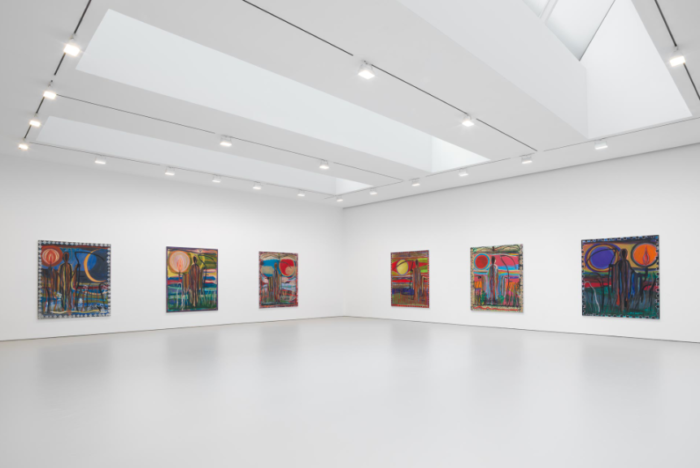Josh Smith is a youngish figurative artist given to painting brightly colored works that include seemingly prehistoric birds with jagged teeth and colorful, extended wings filling the compositional field; death-the-reaper figures; devils in a red background; horizontal spider paintings; and romantic, twilight palm tree landscapes; not to mention a single, self-aggrandizing, large painting of the artist’s own name meeting the visitors as they enter the gallery. This is romantic work that is over the top; it has no shame. Smith seems to work quickly; the gallery’s large spaces are filled with works that circle around general themes: aggressive birds and red devils, among them. Smith is coming from highly expressionist origins, but the whimsical, symbolic nature of his paintings undercuts, to some slight degree, the images’ predilection for a pop flamboyance. The paintings do not occasion thought; rather, they signal an appreciation for color, along with a thematic awareness that tends toward reiterated imagery. In some way, then, they serve well for the spirit of our time, taken as we are with an easy appreciation of art’s purpose, its service to an audience that wants more to enjoy than to deliberate.

Let it be said that there is nothing wrong at all with enjoyment. But in Smith’s case, the pleasure limits the paintings to a narrow spectrum. Smith tends to repeat his color scheme: reds and blues predominate, with some yellows and greens. One wonders if the work is meant to take place somewhere on islands, maybe in the Caribbean. But this is only speculation; it may be just as true that the imagery springs from Smith’s imagination alone. While the show is strong enough, based on its color and sequences of images that generate meaning through similar variations, it is also true that Smith’s paradise is somewhat one-dimensional. And the paradise isn’t perfect–his birds have aggressive heads, while his devils stand out as troubling guardians of a troubled world. As time goes on, this work may seem implausible–in the sense that it is too easily complacent with hipster mores that emphasize alienation and pleasure in the same moment. But, again, this is speculation, an unwise activity if we don’t hear from the artist himself.

The emotional content of the paintings cannot be overstated. The many instances of the pterodactyl-like birds include a round body like that of a turtle and a thin, aggressive head, seen sideways with sharp, protruding teeth. Each bird’s four limbs are thin and bent to fit into the picture plane, and while the coloring and pattern details of each painting are sharply different, the overall gestalt remains the same. The group is an excuse for Smith to experiment with color and design, even as the works detail an actual creature. It is rare to see so much multiplicity of color and variable detail; this is the artist’s strength as a painter. In contrast, the devil series is a single color: red for both figure and background. Holding tridents, with excessively long tails, the devils look more romantic than they do as figures of satanic pride. Sometimes their bones are painted in black; the landscape behind them varies, usually being a series of brightly colored horizontal stripes, and sometimes a pitchfork accompanies the demons as they stand alone. Even Engish poet John Milton’s Satan has been seen, since the romantic era, as a picturesque personage more than the embodiment of evil, and Smith’s devils look rather vulnerable and naive–this despite their history of rebellion, seduction, and immorality.

The death-the-reaper paintings are similar to the bird paintings in that they are in an extended series, with colorful hoods and backgrounds. They are faceless, wear hoods, and carry sickles against a multi-colored sky, usually tending toward twilight or evening. Smith’s vision is generally dark, as these figures demonstrate. But the bright colors stand in contrast to the subject matter–it is as if the artist had decided to paint death on some sort of vacation. That being said, the ambiance is oriented toward the surface rather than the depths, where one might expect an image of death to be. Even so, the image of death the reaper is ancient in Western culture, and as such, commands a presence whose underpinnings remain deep in our unconscious thinking. For that reason alone, the sequence is memorable.
Smith also offers groups of spiders of different colors with human heads and romantic vistas of palm trees in the sunset. The coherence of one body of work to the next is produced by the use of similar color schemes, as well as a dependence on usually troubling topics. But, despite Smith’s reliance on unsettling material, his paintings are joyous enough to overcome their dark proceedings. He can be thanked not only for his prodigal output, but also for a proficiency-based on psychic insight and imagistic invention.
Josh Smith: Emo Jungle at David Zwirner
April 25—July 19, 2019
525 West 19th Street
New York
Images courtesy of David Zwirner Gallery.
